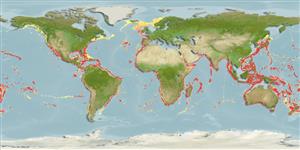Common names from other countries
Environment: milieu / climate zone / depth range / distribution range
Ecologia
marinhas bentopelágico; intervalo de profundidade 200 - 1200 m (Ref. 6181). Deep-water; 70°N - 47°S, 180°W - 180°E
Probably distributed worldwide in tropical and subtropical seas except in eastern Pacific and northern Indian oceans. Large-sized individuals stray in cold-temperate waters off Iceland, Norway, northern Japan and southern New Zealand (Ref. 6181). Reported from 19°41'S, 79°11'W (Ref. 11892).
Tamanho / Peso / Idade
Maturity: Lm ? range ? - ? cm
Max length : 130 cm SL macho/indeterminado; (Ref. 6181); common length : 80.0 cm SL macho/indeterminado; (Ref. 6181)
Espinhos dorsais (total): 20 - 22; Raios dorsais moles (total): 19-24; Espinhos anais 2; Raios anais moles: 18 - 21; Vértebras: 34 - 36. Body fairly elongate and strongly compressed. Mouth with fang-like teeth. The tips of both jaws with dermal processes. Gill rakers degenerated. Color is dark brown with violet tint; fin membranes black; margin of anus black (Ref. 6181).
Adults, benthopelagic to mesopelagic, dwell on the continental slope or underwater rises, migrating to midwater at night (Ref. 6181). Eggs are pelagic (Ref. 6766). Larvae and juveniles, epipelagic to mesopelagic, are rather common in oceanic ichthyoplankton and are only found in the tropics (Ref. 6181). Feed on squid, fish and crustaceans (Ref. 6181). Consumed as food (Ref. 4537).
Life cycle and mating behavior
Maturidade | Reprodução | Desova | Ovos | Fecundidade | Larvas
Nakamura, I. and N.V. Parin, 1993. FAO Species Catalogue. Vol. 15. Snake mackerels and cutlassfishes of the world (families Gempylidae and Trichiuridae). An annotated and illustrated catalogue of the snake mackerels, snoeks, escolars, gemfishes, sackfishes, domine, oilfish, cutlassfishes,. scabbardfishes, hairtails, and frostfishes known to date. FAO Fish. Synop. 125(15):136 p. (Ref. 6181)
Categoria na Lista Vermelha da IUCN (Ref. 130435)
CITES (Ref. 128078)
Not Evaluated
Ameaça para o homem
Harmless
Utilização humana
Pescarias: pouco comercial
Mais informação
ReferênciasAquaculturaPerfil para aquaculturaEstirpesGenéticaElectrophoresesHereditariedadeDoençasProcessamentoMass conversion
Ferramentas
Relatórios especiais
Descarregue XML
Fontes da internet
Estimates based on models
Preferred temperature (Ref.
115969): 6.6 - 14.3, mean 9.6 (based on 988 cells).
Phylogenetic diversity index (Ref.
82804): PD
50 = 1.0000 [Uniqueness, from 0.5 = low to 2.0 = high].
Bayesian length-weight: a=0.00363 (0.00163 - 0.00807), b=3.10 (2.91 - 3.29), in cm Total Length, based on LWR estimates for this (Sub)family-body shape (Ref.
93245).
Nível Trófico (Ref.
69278): 4.3 ±0.71 se; based on food items.
Resiliência (Ref.
120179): Baixo, tempo mínimo de duplicação da população 4,5 - 14 anos (Preliminary K or Fecundity.).
Fishing Vulnerability (Ref.
59153): Very high vulnerability (90 of 100).
